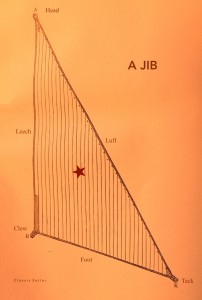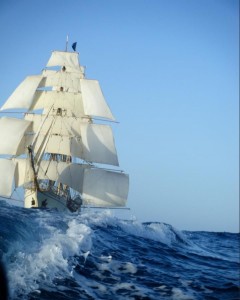Setting a watersail is something you can do in light airs to give you that extra half knot of speed. Typically watersails hang below the boom of a fore and aft sailing vessel, and mostly, on yachts, they are old jibs, or even the spare number two or three where you attach the tack to the end of the boom, bring the head inboard (as here) wrapped around the mast (!) and then use a sheet on the clew to control the sail and stop it dragging too much into the water.

A jib showing the names of the corners and the names of the sides with the luff being the leading edge.
Schooners used a more square form of watersail, often called a bonnet, with a sheet of light line to each clew – outboard and one inboard. The square sail catches more air sailing downwind and there is no reason a yacht could not carry a square bonnet either.
Bonnets have been around for centuries and were properly described as strips of sail that would increase the sail area below it’s normal foot. These were attached with lacings (latchetes) which could be undone to reduce the sail’s area in higher wind. And there could be more than one bonnet on a sail. But they have never been in common use. In 1650 Sir Walter Raleigh mentions bonnets, in his Select Essays and Observations as being something quite new, though in fact they had been around since the middle ages. Bonnets as such gradually became part of the sail, with the lacings remaining as something we call reefing points today.
The lowest bonnet – or watersail also used to be known as a drabbler, and would only ever be used in very light weather. Tall ships like the Europa, here, also carry bonnets on their studding booms, which increase sail area in light weather to give extra speed. Setting sails like these is still a rare sight and not much referred to in the books and drawings of ships – perhaps because a watersail or bonnet further obscures the view of a vessel under her growing clouds of canvas. But any sail like this denotes a busy and well-trained crew who are constantly trying to get the best from their sailing vessel.
Click on images to increase size. DMH


